Concerns about a 54 yr old Wurlitzer vacuum tube organ & safety of old electronics
My musician son recently acquired a Wuriltzer 4100BW organ (1959-1963) in very good working condition. He's plugged it in and says all keys, buttons, pedals, switches etc work and it sounds great. We took the back off and it's dusty/linty inside and I don't think it's been maintained in years...dozens of tubes. It's staying off power until we can decide how safe it is and what's involved with getting it safe, happy and healthy.
I'm electronics hobbiest with an equipped bench but I know nothing about vacuum tubes and never work with mains power other than the occasional power supply projects.
I think it would be a fun project to put the organ in order and I'm looking forward to doing the research and the work.
But I have not ruled out turning it over to an experience repair shop, either.
I'm embarking on a search and research mission and I'm starting at diyaudio instruments forum for sound advice. Except... I've located Morelock's in Mississippi who have the service manual and all parts...so far the only advice they gave me is ...if it isn't broken, don't fix it. I will order the service manual.
Here's my concerns -
Is this thing safe to use as-is?
Is dismantling it...following service manual instructions...and cleaning off the lint, contacts etc, sufficient for safe operation of electronics this age?
Or is that in the realm of .... if it isn't broken....?
Can an aged, failing component take out the entire system? Or will the fuses handle any failure?
I have looked over this sobering thread -
But I don't want to throw in the towel yet. Nor burn down the house or worse....
Any other advice, suggestions, names, links etc? ...and I'll continue searching....
Thanks so much!
Walt
My musician son recently acquired a Wuriltzer 4100BW organ (1959-1963) in very good working condition. He's plugged it in and says all keys, buttons, pedals, switches etc work and it sounds great. We took the back off and it's dusty/linty inside and I don't think it's been maintained in years...dozens of tubes. It's staying off power until we can decide how safe it is and what's involved with getting it safe, happy and healthy.
I'm electronics hobbiest with an equipped bench but I know nothing about vacuum tubes and never work with mains power other than the occasional power supply projects.
I think it would be a fun project to put the organ in order and I'm looking forward to doing the research and the work.
But I have not ruled out turning it over to an experience repair shop, either.
I'm embarking on a search and research mission and I'm starting at diyaudio instruments forum for sound advice. Except... I've located Morelock's in Mississippi who have the service manual and all parts...so far the only advice they gave me is ...if it isn't broken, don't fix it. I will order the service manual.
Here's my concerns -
Is this thing safe to use as-is?
Is dismantling it...following service manual instructions...and cleaning off the lint, contacts etc, sufficient for safe operation of electronics this age?
Or is that in the realm of .... if it isn't broken....?
Can an aged, failing component take out the entire system? Or will the fuses handle any failure?
I have looked over this sobering thread -
But I don't want to throw in the towel yet. Nor burn down the house or worse....
Any other advice, suggestions, names, links etc? ...and I'll continue searching....
Thanks so much!
Walt
The one thing for sure is to provide a three wire power plug with the green ground wire secured firmly to the chassis usually by installing a crimp-on ring connector and securing it under a nut that holds the power transformer or something else close to where the power cord comes in. Scrape away any crud by the nut first to get a good connection.
Get rid of as much dust as you can as this will allow the tubes to cool better. If there are vent holes that are plugged up, clean them out for better air flow.
Check the fuse to see if it is the proper size and type. You might want to replace it as it could blow more easily from being old. It's cheap protection.
It depends how much you want to dig into the amp chassis and how much you know but you could check for proper voltages for the B+ supply and other key voltages. There is a pretty good chance the filter caps will be needing to be replaced, although I have restored four Hammond amps, two Bogens and a few other PA amps all made in the late '50s and early '60s and turned them into guitar amps and have not needed to replace any filter cap. As long as it is working OK, why not just see what happens? You can always replace them later.
If you can get at the switch contacts up by the controls, gently pry them apart and insert some 400 or so grit sandpaper folded in half between them, let go of them and gently pull the sandpaper through to clean them.
There are a lot of really sharp minds in this forum. I'm sure they will have more things to add. It's a good thing that you read up on high voltages in amps. These voltages can be deadly!
Get rid of as much dust as you can as this will allow the tubes to cool better. If there are vent holes that are plugged up, clean them out for better air flow.
Check the fuse to see if it is the proper size and type. You might want to replace it as it could blow more easily from being old. It's cheap protection.
It depends how much you want to dig into the amp chassis and how much you know but you could check for proper voltages for the B+ supply and other key voltages. There is a pretty good chance the filter caps will be needing to be replaced, although I have restored four Hammond amps, two Bogens and a few other PA amps all made in the late '50s and early '60s and turned them into guitar amps and have not needed to replace any filter cap. As long as it is working OK, why not just see what happens? You can always replace them later.
If you can get at the switch contacts up by the controls, gently pry them apart and insert some 400 or so grit sandpaper folded in half between them, let go of them and gently pull the sandpaper through to clean them.
There are a lot of really sharp minds in this forum. I'm sure they will have more things to add. It's a good thing that you read up on high voltages in amps. These voltages can be deadly!
Last edited:
To answer your question about one component taking out everything, the biggest risk would be the power tubes shorting out. It could then take out your output transformer. If you can't test them, I would be tempted to replace them. Are your main filter caps the multi-value can type mounted on top of the chassis? When regular style electrolytics go, they could splatter their guts all over, but not always. Usually they develop a bulge or leak on the ends. Not so much on those can type caps. And they aren't mounted inside where the other components are.
For others that are bringing old tube amps back to life and wish to try to keep the existing filter caps, bring them up slowly on a Variac, like over several hours. Increase 10-20 volts every hour or so This will re-form the filter caps(hopefully).
If you don't have a Variac look up how to make a current limiter. It's basically a 100Watt light bulb in series with the 120V input power. Run it like this for an hour or so and then apply full 120 volt power.
For others that are bringing old tube amps back to life and wish to try to keep the existing filter caps, bring them up slowly on a Variac, like over several hours. Increase 10-20 volts every hour or so This will re-form the filter caps(hopefully).
If you don't have a Variac look up how to make a current limiter. It's basically a 100Watt light bulb in series with the 120V input power. Run it like this for an hour or so and then apply full 120 volt power.
Well the handle is correct. I own lots of old power tubes. They tend to wimp out about 8000 hours use, get soft and flabby, not short out. However, new ones are much more likely to short - in fact I think one of the ones I bought in 2011 is doing that. Organs are not guitar amps, they don't get banged around very much, and mechanical shock is what is likely to kill old tubes. The new ones just aren't built to the same standards.To answer your question about one component taking out everything, the biggest risk would be the power tubes shorting out. It could then take out your output transformer. If you can't test them, I would be tempted to replace them.
The electrolytic caps the second most likely component IMHO to fail. If you don't want to deal with it, Morelock's is famous for doing amp rebuilds for people. The good news about the 4100, there is not much but the amp to have e-caps in it. The rest of the organ is metal reeds and an air blower.
The third wire idea is fine only if the organ hasn't been rained on, so the cotton insulation in the power transformer is rotted. If it is rotted, putting a third wire on the chassis may set the transformer on fire. Many failing churches had roof problems, and this got to be such a problem in old Hammond organs they have a test for it on page 2 of the service manual for Hammond model A, A100, B, BC, BV, B2 blah blah on archive.org. You could have morelock's do this test when they re-e-cap the amp.
If you want to replace the 2 or 3 e-caps in the organ yourself, see this thread about replacing $40 tall cans with two to four radial lead capacitors rated 3000 to 10000 hours service life: http://www.diyaudio.com/forums/tubes-valves/201265-vintage-magnavox-tube-amp-3.html
Be sure to read the safety sticky thread at the head of all sub forums of organforum.com before you attempt to do any work with the back off. It is much more concise than the diyaudio one which wanders off into microwave oven safety about post 2. There are posts about your organ there, mostly under home organ sub forum, but also under the organ repair subforum.
A third component likely to cause trouble in 1959 was the carbon comp resistor, that could change value due to moisture. This is most likely in higher value resistors, 100 kohm and over. These should be checked with an ohmmeter after the power is off and the B+ discharged (see the safety sticky thread). Any with burned paint should be replaced anyway, the paint is what keeps the moisture out.
Also in 1959, paper capacitors not sealed with wax could wander off value due to oxidation from the air. Wurli 4100s are not famous for this, but if you own a capacitor checker you could check the value on the tubular caps. Guitar people always change the paper caps with high voltage on them to the plate or HV grid, but Wurlitzer used a better grade of cap IMHO than guitar amps and I haven't heard of a lot of these shorting out.
Have fun with this classic instrument. It had a reputation for great sound for 1959.
Last edited:
If you read the question asked by optimistic, he asks if there is any "failing component the can take out the entire system". Most likely, this will happen in the power amp section. Replacing the tubes is cheap insurance. A brand new JJ will have a lesser chance of failing than a 60 year old tube. I agree that older tubes were of better quality, but the doesn't mean their tubes are going to hold up. I build guitar amps out of old Hammonds and my Hickok tester has rejected some of them for leakage, gas or shorts to the grid.
By scaring them off of replacing the old power cord with a 3-wire by a remote possibility of a fire seems a bit farfetched to me. The first thing you are advised to do when resurrecting an old amp is to replace the old one with a 3-wire grounding one. There is a 50/50 chance of the chassis becoming energized with line 120 Volts. Would you have them taking a risk of being shocked with 120v? Stories abound of people being hurt or even killed this way. I was an electrician by trade and the single most important addition by far to the Code was adding the ground wire.
By the way a cheap shot about the handle. I thought we advanced past third grade by now
By scaring them off of replacing the old power cord with a 3-wire by a remote possibility of a fire seems a bit farfetched to me. The first thing you are advised to do when resurrecting an old amp is to replace the old one with a 3-wire grounding one. There is a 50/50 chance of the chassis becoming energized with line 120 Volts. Would you have them taking a risk of being shocked with 120v? Stories abound of people being hurt or even killed this way. I was an electrician by trade and the single most important addition by far to the Code was adding the ground wire.
By the way a cheap shot about the handle. I thought we advanced past third grade by now
Last edited:
You say he's already plugged it in and everything works/plays. That seems like a minor miracle to me!My musician son recently acquired a Wuriltzer 4100BW organ (1959-1963) in very good working condition. He's plugged it in and says all keys, buttons, pedals, switches etc work and it sounds great. We took the back off and it's dusty/linty inside and I don't think it's been maintained in years...dozens of tubes. It's staying off power until we can decide how safe it is and what's involved with getting it safe, happy and healthy.
I looked and found this thread with a schematic:
wurlitzer Model 4100bw, 4102bw and 4150bw organ
These tube-generator organs always have a LOT of tubes in the tone generator, and that takes up MOST of the electrical power and generates MOST of the heat.
I (mostly) agree with what's already been said: Since it's operational, just clean out the dust and replace the power supply's electrolytic capacitors, and it should be good to go until something breaks.
I hesitate to answer because people will have strong and varied opinions but ...I agree with the "If it's not broken don't fix it" I'd give it a new power cord. Make sure there is some strain relief where the cord enters the chassis blow out the dust and run with it.
As far as safety. Don't touch any metal parts including patch cords when it's powered on. As for fire...if it bursts into flames in use someone will be right there to take care of it. Might make a good story. Just unplug it when in use.
Evan
As far as safety. Don't touch any metal parts including patch cords when it's powered on. As for fire...if it bursts into flames in use someone will be right there to take care of it. Might make a good story. Just unplug it when in use.
Evan
The tube that I suspect is blowing the fuse on my ST70 amp after twenty minutes on is a 2010 JJ bought in a matched quad from tubesandmore.com, so it is not likely to be counterfeit. Pity, I won't be buying any Russian or chinese tubes. I've got ~70 original Hammond tubes working fine in three organs, 20 of them power tubes.
The power transformer leakage test before installing a chassis ground wire was highly recommended by hammond, being on page 2 of their service manual. Geoelectro of benson electronics service has discussed this at length on organforum.com. Actually geo recommends no third wire, since hammonds are usually hooked up to something else and ground loops can occur. I highly recommend the leakage test before third wire installation; churches pretty universally have leaky roofs before they are sold off. All my 1967 and previous organs have cotton insulation going into the power transformers. A 59 Wurlitzer might also have cotton insulated 110 VAC wiring to the power switch like the hammonds of the time- this should be replaced. Organs have a big walnut insulator around the amp chassis if it is hot, unlike hot chassis TV's with their cardboard insulation. (Mother's 54 Philco used to bite me if the non-polarized cord was upside down).
The power transformer leakage test before installing a chassis ground wire was highly recommended by hammond, being on page 2 of their service manual. Geoelectro of benson electronics service has discussed this at length on organforum.com. Actually geo recommends no third wire, since hammonds are usually hooked up to something else and ground loops can occur. I highly recommend the leakage test before third wire installation; churches pretty universally have leaky roofs before they are sold off. All my 1967 and previous organs have cotton insulation going into the power transformers. A 59 Wurlitzer might also have cotton insulated 110 VAC wiring to the power switch like the hammonds of the time- this should be replaced. Organs have a big walnut insulator around the amp chassis if it is hot, unlike hot chassis TV's with their cardboard insulation. (Mother's 54 Philco used to bite me if the non-polarized cord was upside down).
Last edited:
I totally agree with you indianajo about older tubes. I use late '50s and early to mid '60s tubes exclusively in the amps I restore/mod/build, but they have been fully tested on my Hickok tester. I feel they have a much fuller sound, more harmonics, complex tone. I was merely suggesting to the owner that, without knowing the condition of the output tubes, that the most likely catastrophic event he was asking about would likely happen in the power section. And that chain of events could easily start with an untested, leaky, soon to go bad tube. I didn't say it would, merely answering his question.
That problem you refer to is an interesting one. Yes,it would be good for optimistic to test the transformer and many other things, but I feel that this is beyond his capability,otherwise he probably would have done so already. I agree with you on that as well. It really would be best to have a full diagnostic battery of tests by a competent tech. You always are taking chances with older amps unless you have the means to test everything or take it to a tech.
You stated "geo recommends no third wire, since hammonds are usually hooked up to something else and ground loops can occur". What is "something else"? I'm not sure what you mean. Also, there are easy ways to minimize ground loops. Star ground,etc.
You said the tube you "suspect" is blowing the fuse on your Dynaco is a JJ. Have you tested it?
I'm also wondering that if geo recommends the transformer test,wouldn't the whole amp be suspect since so many of these got wet? Why not test the output tranny? It has 400 volts going to the center tap. Or is it because a different insulation was used?
That problem you refer to is an interesting one. Yes,it would be good for optimistic to test the transformer and many other things, but I feel that this is beyond his capability,otherwise he probably would have done so already. I agree with you on that as well. It really would be best to have a full diagnostic battery of tests by a competent tech. You always are taking chances with older amps unless you have the means to test everything or take it to a tech.
You stated "geo recommends no third wire, since hammonds are usually hooked up to something else and ground loops can occur". What is "something else"? I'm not sure what you mean. Also, there are easy ways to minimize ground loops. Star ground,etc.
You said the tube you "suspect" is blowing the fuse on your Dynaco is a JJ. Have you tested it?
I'm also wondering that if geo recommends the transformer test,wouldn't the whole amp be suspect since so many of these got wet? Why not test the output tranny? It has 400 volts going to the center tap. Or is it because a different insulation was used?
I've got just these four thoughts on the subject:
Lots of good advice already in this thread, good references to the organ forum.
- For safety reasons a three wire cord should always be fitted. (In line with forum policy on such things as well.)
- A mains fuse if not already present should be fitted on the hot side and before the power switch.
- A transformer with known bad insulation should be replaced with a functionally equivalent transformer.
- I've yet to see a vintage power tube fail in a way similar to the way modern power tubes often do; i.e. catastrophically, there are exceptions like the SVT, and some guitar amps, but in dozens of amps I've seen only modern power tubes fail and do serious damage. (The older ones mostly just seem to wear out, and sometimes go gassy which is not a good thing admittedly.)
Lots of good advice already in this thread, good references to the organ forum.
I agree about the newer tubes failing more. Then I started thinking about why. The Bogen CHA33 has 6L6s with 480 plate and only 340 screen volts. Hammond AO-35(everybody'e favorite,Dr. Z Carmen Ghia anyone?) El84s with only 300v plate and 290v screen. AO-29, power amp for the M series organs 305V plate and 295V screen for 6V6s. Silvertone(Danelectro) 1483 has 350v plate and 340v screen with 6L6s. 1484 has 475v plate and only 340V screen for 6L6s. 1474 has only 345v plate and 340v screen. Catch my drift? These amps are hardly even breathing.
Today's amps- my Fender Hot Rod Deville has 485v plate, 483v screen. I could go on and on. We are pushing today's amps to the edge for power output. The old amps routinely had 30-35 watts out of a pair of 6L6s. I have four old PA amps in my shop right now with 6L6s and all are rated for 30-35 watts.
There will be no way to prove it, but I suspect if you had a batch of new JJs cruising along at 30-35 watts, I would think that they would not short out like they are now. Don't get me wrong, I love the sound of old tubes. Like I said in my previous post, I use them exclusively in my vintage amps.
Just a little food for thought.
Today's amps- my Fender Hot Rod Deville has 485v plate, 483v screen. I could go on and on. We are pushing today's amps to the edge for power output. The old amps routinely had 30-35 watts out of a pair of 6L6s. I have four old PA amps in my shop right now with 6L6s and all are rated for 30-35 watts.
There will be no way to prove it, but I suspect if you had a batch of new JJs cruising along at 30-35 watts, I would think that they would not short out like they are now. Don't get me wrong, I love the sound of old tubes. Like I said in my previous post, I use them exclusively in my vintage amps.
Just a little food for thought.
i whole heartedly agree that a three wire grounded ac cord is a safety must with old equipment.but if the capacitor that is intended to "ground" the chassis to the neutral of the ac isn't removed (and is leaky) it still presents a potential shock hazard.i'm mentioning this because i recently dealt with this very situation, a well intending young guitar player replaced the line cord on an old Traynor Bass Mate but didn't remove the cap and worse yet didn't pay attention to the polarity of the new ac cord; a quick test revealed that 70 vac was on the chassis but the burn print of an SM 58 windscreen on his lower lip and chin let me know that he discovered his mistake in an inopportune way!
i whole heartedly agree that a three wire grounded ac cord is a safety must with old equipment.but if the capacitor that is intended to "ground" the chassis to the neutral of the ac isn't removed (and is leaky) it still presents a potential shock hazard.i'm mentioning this because i recently dealt with this very situation, a well intending young guitar player replaced the line cord on an old Traynor Bass Mate but didn't remove the cap and worse yet didn't pay attention to the polarity of the new ac cord; a quick test revealed that 70 vac was on the chassis but the burn print of an SM 58 windscreen on his lower lip and chin let me know that he discovered his mistake in an inopportune way!
The death cap of course needs to be removed, but the fact that there was AC on the chassis means that it was not effectively grounded whether by a grounding failure somewhere else or by an actual wiring mistake when the 3 wire cord was installed. The grounding conductor is sized (same conductor gauge as the current carrying conductors) such that the full fault current should not result in a hazardous potential on the chassis if everything works as intended.
he did install the new line cord incorrectly as i mentioned.and as i was not present at the show where he burnt his lip i can't say for certain that the receptacle he used was grounded but the mic sure was!
Last edited:
With the amp of a Wurlitzer sitting inside 50 lb of hardwood, setting fire to the amp transformer by installing a third ground wire on an amp with a leaky transformer without checking, is way more of a fire hazard to the house than a hifi amp sitting out on a glass shelf somewhere where someone could touch it.
Do the leakage test before installing the ground wire. I did on my H100. The hammond leakage spec in the document quoted (service manual on archive.org) is about 1/4 the current of the trip point of a ground fault interrupter socket.
Furthermore, rather than grounding the chassis buried down in the bottom of the walnut case with a wood cover on the back, I third wire grounded the metal keyboard chassis I actually touch: Using no connectors but crimped 20 amp rated ring terminals to 16 ga wire, machine screws and nuts, and stainless star washers to the sheet metal per the safety boards spec of more than one contact point to every surface accesible to the consumer. My H100 power chassis where the power cord comes in is connected to the metal keyboard on the ground by 6 amp rated AMP Mate-n-lock 2 connectors, that could easily melt away under a 20 amp dead short.
There is a long complicated thread on organforum.com hammond subforum about power cord installation and third wire contributitions/risk adders. Read it, most of it would apply to any 1950's organ with a vacuum tube or transistor amp.
Do it right or don't ask questions and don't change anything. If you don't change anything you can sue the (bankrupt) Wurlitzer corp because your organ shocked you. In fact, you're much safer buying an MP3 player to replace the organ that uses batteries and lets a professional do the playing. You might wear out your fingers on a real keyboard, who would you sue then?
Do the leakage test before installing the ground wire. I did on my H100. The hammond leakage spec in the document quoted (service manual on archive.org) is about 1/4 the current of the trip point of a ground fault interrupter socket.
Furthermore, rather than grounding the chassis buried down in the bottom of the walnut case with a wood cover on the back, I third wire grounded the metal keyboard chassis I actually touch: Using no connectors but crimped 20 amp rated ring terminals to 16 ga wire, machine screws and nuts, and stainless star washers to the sheet metal per the safety boards spec of more than one contact point to every surface accesible to the consumer. My H100 power chassis where the power cord comes in is connected to the metal keyboard on the ground by 6 amp rated AMP Mate-n-lock 2 connectors, that could easily melt away under a 20 amp dead short.
There is a long complicated thread on organforum.com hammond subforum about power cord installation and third wire contributitions/risk adders. Read it, most of it would apply to any 1950's organ with a vacuum tube or transistor amp.
Do it right or don't ask questions and don't change anything. If you don't change anything you can sue the (bankrupt) Wurlitzer corp because your organ shocked you. In fact, you're much safer buying an MP3 player to replace the organ that uses batteries and lets a professional do the playing. You might wear out your fingers on a real keyboard, who would you sue then?
Last edited:
Indianajo, I went to that archive.org site and read page 2 of two different models and nowhere in those two do they refer to any fire hazard. What they did refer to is safety measures for voltage on the chassis- a problem that will be nullified with proper grounding. Yes, by all means, if this is such a big problem(organs being rained on from leaky church roofs) test the transformer.
You said the leakage current quoted in the page 2 test is 1/4 the value of the trip point of a GFI receptacle. This value is 1.25ma-the trip point being 5mA for a GFI. It's really hard to believe 1.25mA will cause any harm.
You mention a connector being melted with a 20A direct short. A direct short of household 120v is upwards of 10,000 Amps-yes AMPS. That will melt almost anything. That's what the circuit breakers in your electrical panel are for, to clear the circuit before any fire starts.
These numbers are accurate- I was a commercial electrician for 35 years.
At the end, you say do it right or don't ask questions. It is well established by the moderator and policy of this forum to properly ground chassis if a two wire cord exists. The remote possibility of a fire in all vintage transformers exists, but there is a very real possibility of getting an energized chassis that is not properly grounded.
You said the leakage current quoted in the page 2 test is 1/4 the value of the trip point of a GFI receptacle. This value is 1.25ma-the trip point being 5mA for a GFI. It's really hard to believe 1.25mA will cause any harm.
You mention a connector being melted with a 20A direct short. A direct short of household 120v is upwards of 10,000 Amps-yes AMPS. That will melt almost anything. That's what the circuit breakers in your electrical panel are for, to clear the circuit before any fire starts.
These numbers are accurate- I was a commercial electrician for 35 years.
At the end, you say do it right or don't ask questions. It is well established by the moderator and policy of this forum to properly ground chassis if a two wire cord exists. The remote possibility of a fire in all vintage transformers exists, but there is a very real possibility of getting an energized chassis that is not properly grounded.
Last edited:
Page 2 Hammond Service Manual
reat care has bean taken In the design and manufacture of this product to assure that no
shock hazard exists on any exposed metal parts. Internal service operations can expose the
technician to hazardous line voltages and accidentally cause these voltages to appear on
exposed metal parts during repair or reassembly of product components. To prevent this, work
on these products should oniy be performed by those who are thoroughly familiar with the
precautions necessary when working on this type of equipment.
To protect the user, It Is required that all enclosure parts and safety Interlocks be rettored to
their original condition and the following tests be performed before returning the product to
the owner aftor any service operation.
Plug the AC iine cord directiy Into a line voltage AC receptacle (do not use an Isolation
transformer for this test) and turn the product on. Connect the network (as shown below) In
senes with all exposed metal parts and a Known earth ground such as a water pipe or conduit.
Use an AC VOM of 5,000 ohms per volt or higher sensitivity to measure the voltage drop across
the network. Move the network connection to each exposed metal part (metal chassis, screw
heads, knobs and control shafts, escutcheon, etc.) and measure the voltage drop across the
network. Reverse the line plug and repeat the measurements. Any reading of 4 volts RMS or
more is excessive and indicates a potential shock hazard which must be corrected before
returning the product to the use
Here is the text of page 2 Indianajo refers to. There is a diagram of how to perform the test that follows. I see nothing about fires here, only energized chassis. The letter G was cut off at the very beginning for some reason-Great care... They are referring to connecting one lead of a meter to grounded pipe; at that time, no grounded outlets existed. You needed to go find a ground. It would be best to extend this ground to any metal parts which have live parts in them, as Indianajo alluded to.
reat care has bean taken In the design and manufacture of this product to assure that no
shock hazard exists on any exposed metal parts. Internal service operations can expose the
technician to hazardous line voltages and accidentally cause these voltages to appear on
exposed metal parts during repair or reassembly of product components. To prevent this, work
on these products should oniy be performed by those who are thoroughly familiar with the
precautions necessary when working on this type of equipment.
To protect the user, It Is required that all enclosure parts and safety Interlocks be rettored to
their original condition and the following tests be performed before returning the product to
the owner aftor any service operation.
Plug the AC iine cord directiy Into a line voltage AC receptacle (do not use an Isolation
transformer for this test) and turn the product on. Connect the network (as shown below) In
senes with all exposed metal parts and a Known earth ground such as a water pipe or conduit.
Use an AC VOM of 5,000 ohms per volt or higher sensitivity to measure the voltage drop across
the network. Move the network connection to each exposed metal part (metal chassis, screw
heads, knobs and control shafts, escutcheon, etc.) and measure the voltage drop across the
network. Reverse the line plug and repeat the measurements. Any reading of 4 volts RMS or
more is excessive and indicates a potential shock hazard which must be corrected before
returning the product to the use
Here is the text of page 2 Indianajo refers to. There is a diagram of how to perform the test that follows. I see nothing about fires here, only energized chassis. The letter G was cut off at the very beginning for some reason-Great care... They are referring to connecting one lead of a meter to grounded pipe; at that time, no grounded outlets existed. You needed to go find a ground. It would be best to extend this ground to any metal parts which have live parts in them, as Indianajo alluded to.
Last edited:
Thank you very much everyone for the generous and informative replies. I read them all and I'll read them again. The service manual arrived today. Stepping into the past. I'll figure out how to properly clean it of lint and dirt but first stop is organforum.com. For sure I want to get it in proper working order and safe and sound...and live to tell about it. Thanks again, and I'll be back. Probably before any changes.
Walt
Walt
Finally found time to plunge into the organ. It was a massive eye opener. I thought I could pull the PS & Amp and bring it back to my house for cleaning and testing. Ha! Massive busy cable harnesses, all soldered down. It was a very gratifying vacuuming experience but I need a strategy for cleaning this and doing the testing in place. I didn't see any obvious exploded or burned items. Cloth wires at the transformer. Those who send the amp to Morelocks for a refurb...this is a "project"...right? I'm going to figure out how to do the transformer leakage test first, without dissassembling anything. Tips and tricks appreciated. And I'll keep studying. Thanks so much for the help so far. Here's some pix:
Attachments
-
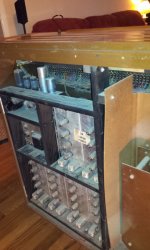 closedbackleft.jpg129.1 KB · Views: 126
closedbackleft.jpg129.1 KB · Views: 126 -
 ampandps.jpg158.9 KB · Views: 129
ampandps.jpg158.9 KB · Views: 129 -
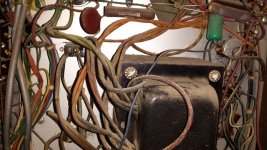 clothwire.jpg135.8 KB · Views: 113
clothwire.jpg135.8 KB · Views: 113 -
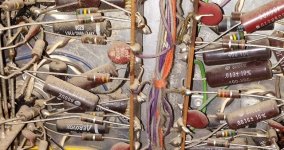 components.jpg148.4 KB · Views: 121
components.jpg148.4 KB · Views: 121 -
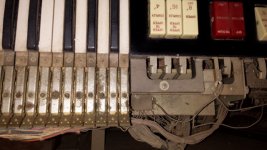 keys.jpg95 KB · Views: 123
keys.jpg95 KB · Views: 123 -
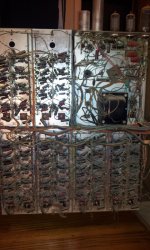 lintfarm.jpg169.8 KB · Views: 105
lintfarm.jpg169.8 KB · Views: 105 -
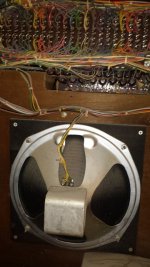 speaker.jpg100.7 KB · Views: 107
speaker.jpg100.7 KB · Views: 107 -
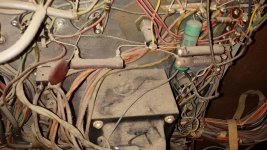 transformer.jpg134.9 KB · Views: 101
transformer.jpg134.9 KB · Views: 101 -
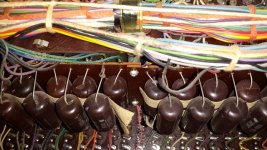 underkeys.jpg137.4 KB · Views: 95
underkeys.jpg137.4 KB · Views: 95 -
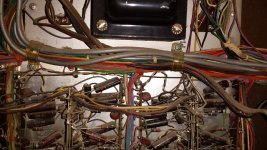 wiring1.jpg135.9 KB · Views: 123
wiring1.jpg135.9 KB · Views: 123
from the pic's it's cleaner then some i've seen and worked on!
small used tooth brushes and Q-tips make cleaning in tight spaces easier.(be careful during the cleaning process not to move too many components back and forth in an effort to get behind them to clean;flexing the component leads can break them away) keep the vacuum close at hand. try to avoid using high pressure air to blow it out and steer clear of the temptation of "dousing it with contact cleaner"
don't neglect removing the drivers to clean the front side of the cone you'd be surprised as to how much small particles of schmutz can make it through the grill cloth with the typical build up at the bottom that can make some drivers sound frappy or cracked.(good time to check them for damage)
don't use glass cleaner with ammonia on tubes it tends to remove the numbers!(mild dish soap and warm water don't immerse them for the sake of the pins developing corrosion)
other than that patience and a methodical approach and always make notes!
small used tooth brushes and Q-tips make cleaning in tight spaces easier.(be careful during the cleaning process not to move too many components back and forth in an effort to get behind them to clean;flexing the component leads can break them away) keep the vacuum close at hand. try to avoid using high pressure air to blow it out and steer clear of the temptation of "dousing it with contact cleaner"
don't neglect removing the drivers to clean the front side of the cone you'd be surprised as to how much small particles of schmutz can make it through the grill cloth with the typical build up at the bottom that can make some drivers sound frappy or cracked.(good time to check them for damage)
don't use glass cleaner with ammonia on tubes it tends to remove the numbers!(mild dish soap and warm water don't immerse them for the sake of the pins developing corrosion)
other than that patience and a methodical approach and always make notes!
Last edited:
- Status
- Not open for further replies.
- Home
- Live Sound
- Instruments and Amps
- Concerns about a 54 yr old Wurlitzer vacuum tube organ & safety of old electronics